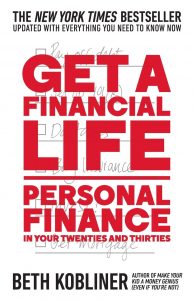Get A Financial Life
Personal Finance In Your Twenties And Thirties

Financial matters don't have to be scary! The St. Tammany Parish Library has a wealth of resources available for patrons to peruse. Previously, we covered You Need A Budget, opens a new window, and guides on investing and online resources. Today we will be covering Get A Financial Life by Beth Kobliner. Any advice therein is from the book, not St. Tammany Parish Library, and is simply being reiterated for review purposes.

Beth Kobliner comes highly regarded as a financial expert. In addition to authoring Get A Financial Life, she has also authored the New York Times Bestseller Make Your Kid a Money Genius (Even if You Aren't), opens a new window. Kobliner is a graduate of Brown University and an experienced financial columnist, writing for the New York Times, Huffington Post, and Mint.com. She has appeared on Oprah, served as an advisor to NPR, the Obama administration, The Wall Street Journal, Reader's Digest, and even Sesame Street.
Kobliner originally published Get A Financial Life in 1996, and it quickly rose to become a New York Times Bestseller. Since then, Kobliner has routinely edited, updated, and republished the book, most recently in 2017, shortly before I read it for the first time. The book is neatly divided into ten parts: a cliff notes-like summary, financial evaluation, debt, banking, investing, retirement, home buying, insurance, taxes, and government and military related advice. Each section is well written and formulaic, with an anecdote or two to help convey points and demonstrate the financial math at play.
Those looking for the quick and easy advice can certainly start at chapter one, where Kobliner covers the big points: pay off debt, organize your budget, and set aside money for savings and retirement. The first chapter is a whopping ten pages and barely serves as a way to dip your feet into the shallow end of the proverbial pool of finance. The advice comes quick and easy to digest, and while this will probably be helpful to many first time readers, the author insists that reading more can only benefit her audience. Frankly, I agree.
Her second chapter, Taking Stock of Your Financial Life, is pretty self-explanatory. Really, this chapter is all about accurate budgeting, realizing how much money you spend on your day to day life, and the advise on how to improve them. A lot of times, simply seeing your expenses on paper right in front of you is enough to make one realize how much work is being done and can be done.
Twenty pages later, we meet Dealing With Debt. Debt's not fun, but most people at one point or another have to make use of it. Kobliner's advice is pretty straight forward here: pay it off! If you have enough of it, pay off the debt that costs the most, typically high interest credit card debt. The author is not totally against using credit cards, so long as you can manage them, and sometimes they can even provide neat perks like frequent flyer miles. She also advises reaching out to your credit card companies when you're in trouble; speak frankly and oftentimes they might cut you some slack by cutting your rates or extending payments. Useful tips!
When it comes to banking, the future is now. In a society revolving around the internet, online banks are simply the way to go. Chapter 4 spells this out plainly, and points out that most, if not all online banks, feature APR superior to brick-and-mortar establishments. These banks are all FDIC approved, and quite a few offer free or reimbursed ATM fees. The downside of course is a slight delay in your transactions, so things might get hairy if you absolutely need money right this second, but a little planning can solve all of these problems.
Get A Financial Life dedicates thirty pages to the topic of investing. While this is one of the largest chapters in her book, the reality is that many authors dedicate entire books to the subject. Kobliner's advice follows the trend of many experts: max your retirement savings first, then dedicate a percentage of your income to something long-term. The author recommends mutual funds as a relatively easy and safe way to get started, though she also discusses company stock trading, bonds, and other methods.
On the subject of retirement, driving the point home, Kobliner has an entire chapter dedicated to your retirement. Take care of yourself first and save more now rather than later, because compound interest is a powerful force.
As far as home acquisition goes, Kobliner discusses both renting and purchase. As with her earlier chapters, she offers useful advice regarding saving money, such as improving your credit to secure better rates for a home loan or refinancing to a better loan for your situation. The author also suggests simply reaching out to your landlord if you have one and trying to secure better rent terms, if you can manage. Hey, if you can convince your landlord to upgrade to EntergyStar appliances and save both of you money on utilities, that's a win-win.
Insurance is the final chapter of relevancy to most readers while still being up to date. As in the other topics, there are numerous options a financially savy person can pursue. Generally speaking, employer-provided insurances are almost always cheaper than getting it on your own. Readers also have access to opinions on whether to get health or life insurance, and various insurances for home, apartment, car, etc., as well as how much you should reasonably need. Insurance can be tricky as many factors can come into play: a homeowner on one street might need flood insurance while his friend three blocks over does not. Such research and insights is useful.
The final two chapters are of less import to the reader. As a topic, paying taxes is of course very important, but tax codes ae constantly in flux, not just in the particulars but also available loopholes. Kobliner has much to say here, but take it with a grain of salt. The final chapter covers potential benefits and resources to military personnel and veterans, which readers may find of use, if they are not already aware.
So, where does that put Get A Financial Life: Personal Finance in Your Twenties and Thirties? As you may have guessed, Kobliner's book is firmly aimed at the young adult crowd, those people taking their first steps into the world of adult finances. Much of the above advice (as well as the dozens of pages and topics not covered above!) will suffice for the beginner, or someone doing a really hard reevaluation. Older adults who've been working quite a while and already have homes and investment portfolios might not find a lot of new ground to cover.
Be that as it may, Get A Financial Life is still highly regarded and respected. The book is full of accolades from numerous reviewers, and I personally recommend it as both an excellent starting point as well as a pretty good place to get a refresher. Hopefully we get a new edition for the post-2020 world!


Add a comment to: Financial Literature: Get A Financial Life